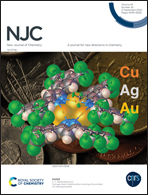Systematic investigation of Eu3+ activated Na2Ln4(MoO4)7 [Ln = La, Gd and Y] narrow band red emitting phosphors for hybrid white LEDs and plant growth†
Abstract
A sequence of Eu3+ activated Na2Ln4(MoO4)7 [Ln = La, Gd and Y] red phosphors has been synthesized using a conventional solid-state method. The phase formation and structural analysis of the synthesized phosphor compositions were analyzed by X-ray diffraction followed by Rietveld refinement. All of the optical studies were executed systematically for the Eu3+ activated Na2Ln4(MoO4)7 red phosphors, all of them showed an intense red emission at 616 nm, owing to the 5D0 → 7F2 electric dipole (ED) transition. The synthesized phosphors show a decent thermal stability, and it retains a moderate percentage of the emission intensity at 423 K; the absolute internal quantum efficiency (IQE) was also found to be 79%. The red (conjugated with a near ultraviolet light emitting diode (UV LED)) and white light emitting diodes (LEDs) (conjugated with a blue light emitting diode (LED) + yellow organic dye) were fabricated by using the synthesized phosphor composition, the red LED showed an intense red emission and the white LED showed a warm white light emission with a Commission Internationale de l’Eclairage (CIE) color coordinate of 0.300, 0.379 and attractive color rendering index (CRI) (80%) and correlated color temperature (CCT) (6713 K) values. In addition, Sm3+ alone and Eu3+, Sm3+ co-doped Na2Ln4(MoO4)7 orange-red phosphors were synthesized, and their corresponding LEDs were fabricated for plant growth applications. The electroluminescence (EL) spectrum of the present phosphor entirely covers the absorption spectrum of phytochrome Pr. The obtained results reveal the synthesized red phosphor could be a potential red-emitting component in the white LED, as well as having possible applications as a plant growth LED.
![Graphical abstract: Systematic investigation of Eu3+ activated Na2Ln4(MoO4)7 [Ln = La, Gd and Y] narrow band red emitting phosphors for hybrid white LEDs and plant growth](/en/Image/Get?imageInfo.ImageType=GA&imageInfo.ImageIdentifier.ManuscriptID=D0NJ03766D&imageInfo.ImageIdentifier.Year=2020)


 Please wait while we load your content...
Please wait while we load your content...